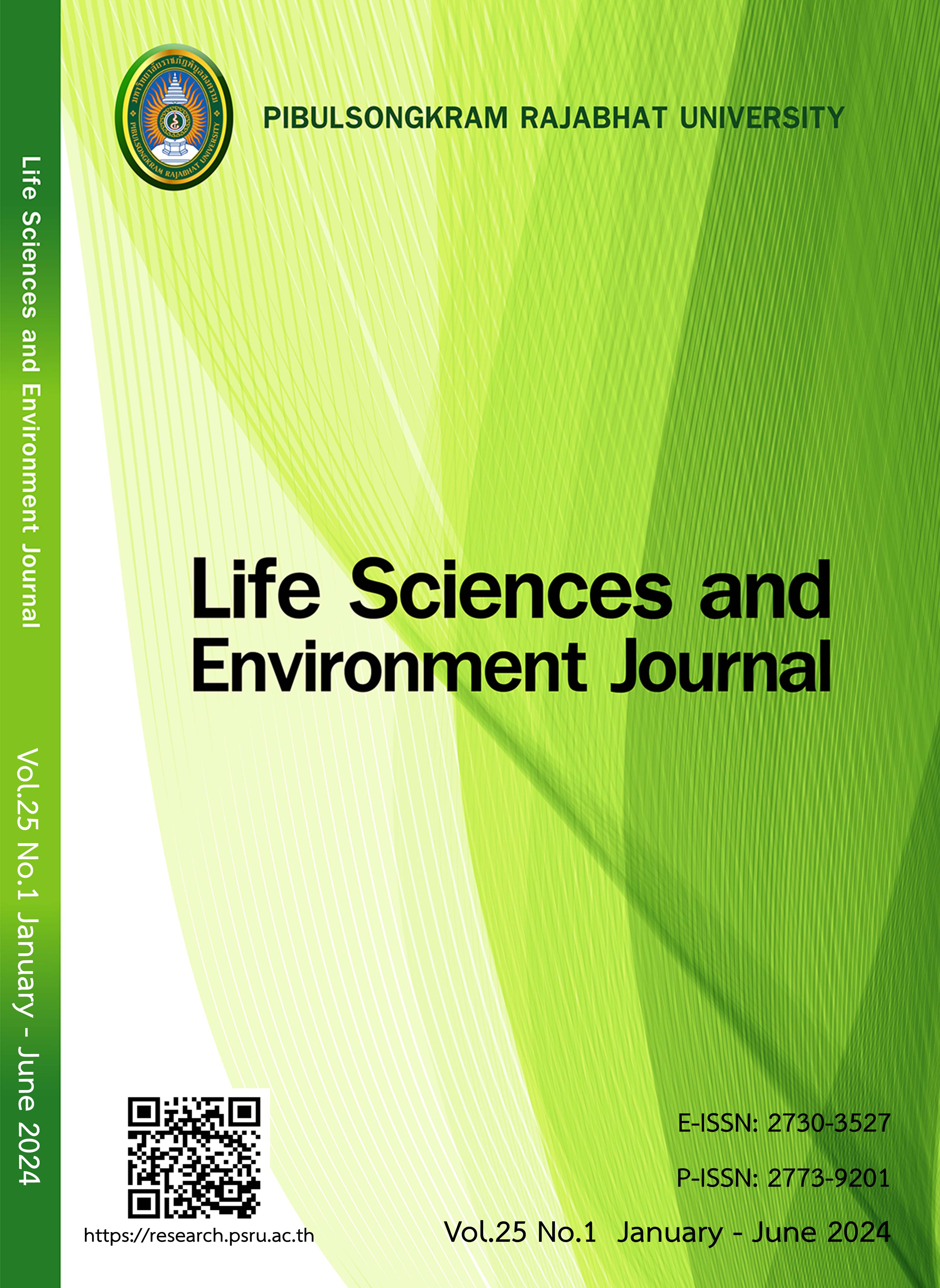CHEMICAL COMPOSITIONS AND BIOACTIVE COMPOUNDS OF LEMONGRASS ESSENTIAL OILS AGAINST MICROBIAL PATHOGEN AND DRUG-RESISTANT EXTENDED SPECTRUM ß-LACTAMASE (ESBL) PRODUCING GRAM-NEGATIVE
DOI:
https://doi.org/10.14456/lsej.2024.2Keywords:
antibacterial, drug resistance, essential oils, lemongrassAbstract
The purpose of this study was to investigate and analyze the chemical compositions and major components of essential oils extracted from lemongrass leaves in the Sathing Phra Peninsula, Songkhla Province. Lemongrass was extracted by steam distillation, and its chemical composition was analyzed using Gas Chromatography Mass Spectrometry (GC-MS). It was discovered that the extracted essential oil contained up to 260 different chemical components, with important substances unique to the chemistry of lemongrass essential oil found in the monoterpene group, both terpene aldehyde and terpene alcohol in the form of citral, neral, geranial, geraniol, and others. In addition, there was a study of the effectiveness of lemongrass essential oil against six strains of pathogenic bacteria and drug-resistant bacteria, such as Escherichia coli ATCC 25923, Staphylococcus aureus SP1, Streptococcus pyogenes SV1, Escherichia coli A3 (ESBLs), Pseudomonas aeruginosa A2 (ESBLs), Klebsiella pneumoniae A1 (ESBLs). The disc diffusion assay method discovered that the extracted lemongrass essential oil had antimicrobial properties, with the most effective strain being S. pyogenes, which had an zone of inhibition size of 34.55±0.25 millimeters and could against all three strains of drug-resistant pathogens, with the highest efficiency against E. coli A3 (ESBLs), which had an inhibition zone size of 11.38±0.99 millimeters and inhibition zone size of Inhibits resemble to K. pneumoniae A1 (ESBLs), which has a size of 9.99±0.25 millimeters.
References
Adcharatt S, Rangsima S, Suparat S. The inhibitory efficiency of the essential oil from lemon grass and citronella grass on the growth of Bovine mastitis pathogens: Staphylococcus aureus, Streptococcus agalactiae and Escherichia coli. Khon Kaen Agriculture Journal 2012;40(2):230-235.
Aristides L, Edeltrudes L, Evandro Souza, Margareth D, Vinícius Nogueira T, Isac M. Inhibitory effect of
ß-pinene, α-pinene and eugenol on the growth of potential infectious endocarditis causing Gram-positive bacteria. Revista Brasileira de Ciências Farmacêuticas Brazilian Journal of Pharmaceutical Science 2007;43:121-126.
Bamrasnaradura Infectious Diseases Institute. (2020). Guidelines for infection prevention and control in hospital. Ministry of Public Health. Nonthaburi.
Bruno PB, Luis CM, Angelica PR, Barbara C, Marcus A, Carlos W, et al. Bioactivity of the Cymbopogon citratus (Poaceae) essential oil and its terpenoid constituents on the predatory bug, Podisus nigrispinus (Heteroptera: Pentatomidae). Scientific reports 2019;9(8358):1-8.
Chao S, Kaikuo S, Xiaorong Z, Yi S, Yue S, Yifei C. Antimicrobial activity and possible mechanism of action of citral against Cronobacter sakazakii. Plos one 2016;14:1-12.
Josphat CM, Isabel W, Jesca L.N, Anderson MK. Chemical composition of Cymbopogon citratus essential oil and its effect on mycotoxigenic Aspergillus species. African journal of food science 2011;5(3):138-142.
Kexin G, Ping O, Yuxin H, Yuyun D, Ting T, Changliang H, et al. Geraniol inhibits biofilm formation of methicillin-resistant Staphylococcus aureus and increase the therapeutic effect of vancomycin in vivo. Frontiers microbiology 2022; 1-12.
Luis R, Melissa G, Irasema V, Gustavo G, Miguel M, Fernando A. Inhibition of Glucosyltransferase Activity and Glucan Production as an Antibiofilm Mechanism of Lemongrass Essential Oil against Escherichia coli O157:H7. Antibiotics 2020; 9(102):1-12.
Mehdi H, Behnoush M, Stephane S, Monique L. Antibacterial activity of cranberry juice concentrate on freshness and sensory quality of ready to eat (RTE) foods. Food Control 2017;75:134-144.
Mohammad M, Sadaf C, Mo Ahamad K, Palmiro P, Masroor K, Jamin A, et al. Lemongrass essential oil components with antimicrobial and anticancer activities. Antioxidants 2022;11(20):1-23.
Nitish K, Sunil K, Singh SP, Rekha R. Enhanced protective potential of novel citronella essential oil microsponge hydrogel against Anopheles stephensi mosquito. Journal of Asia-Pacific entomology 2021;24:61–69.
Phuntip K, Ratchanee T, Suwimol T, Buppha R. Infection Situation, Antimicrobial Susceptibility Trends, and Guidelines for Caring Patients with Drug-Resistant Infections for Nurses at Sikao Hospital, Trang Province. Journal of Health and Pedagogy 2023;3(2):62-78.
Supharat D, Suchada M, Petnumpung R. Antioxidant and antimicrobial activities of essential oil from Thai Herbs to microorganisms causing dermatitis. KKU Science Journal 2020; 48(1):76-85.
Suwaree D. The prevalence of extended spectrum -lactamase producing in K.pneumoniae and E.coli at Phatthalung hospital. Region 11 Medical Journal 2016;30(2):97-103.
Tanongsak L. Sathing Phra ancient community. 2020. Available at https://archaeology.sac.or.th/: archaeology/115. Accessed September 19, 2023.
Wei G, Min Q, Zhonghui P, Nana L, Min Y, Ke R, et al. Geraniol-a potential alternative to antibiotics for bovine mastitis treatment without disturbing the host microbial community or causing drug residues and resistance. Frontiers in Cellular and Infection Microbiology 2023;1-23.
Downloads
Published
How to Cite
Issue
Section
License
Copyright (c) 2024 Life Sciences and Environment Journal

This work is licensed under a Creative Commons Attribution-NonCommercial-NoDerivatives 4.0 International License.
Each article is copyrighted © by its author(s) and is published under license from the author(s).










